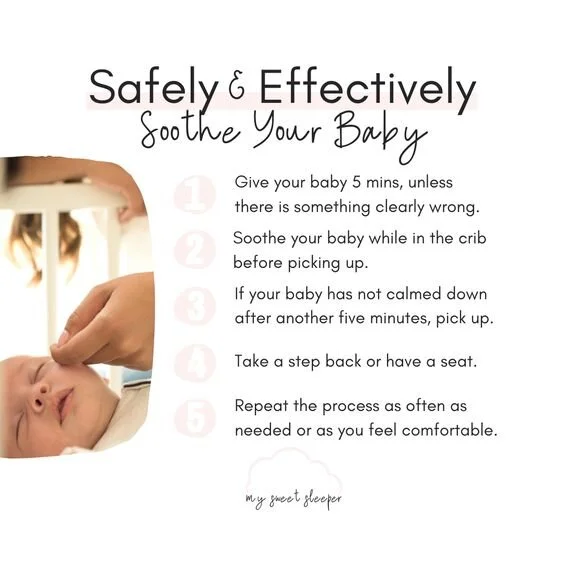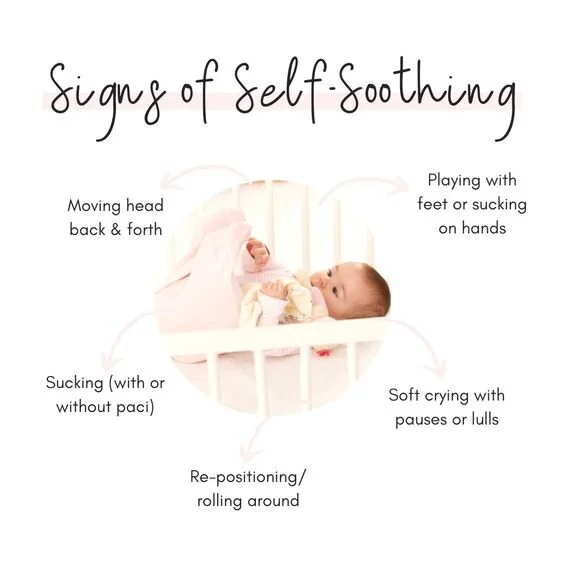Five steps to teach your baby how to self-soothe (and what that really means)
There is nothing quite like the feeling of snuggling your baby before bed. These are the moments we longed for before we met our babies and the memories we will remember when they are older. Babies need skin to skin in order to self regulate, and it is actually crucial for their independence later on.
But what happens when your baby wants the snuggling to last all night and refuses to sleep unless they are pressed up against your chest? Or when your baby cries as soon as you set her down in the crib, or in the middle of the night when she realizes you aren’t there? While this IS normal, and it makes sense (why would you want to sleep in a crib when you can sleep on mom who is warm and snuggly), it can be challenging when you need to get stuff done during the day and get much needed sleep at night!
If you’ve researched “how to get my baby to sleep” you can probably come across the term “self-soothing”. The concept of helping your baby to soothe themselves to sleep without the need for a parent. This term has also been linked to crying for periods of time in order to learn these skills. Some parents choose a “cry-it-out” (CIO) approach, which involves allowing your baby to cry him/herself to sleep in hopes that the child will learn to sleep independently and self-regulate on their own. There are also variations of the CIO method such as “Ferberizing,” where the child may cry and learn to self-soothe for a predetermined amount of time before the parents intervene to provide comfort.
But you have also likely read that these approaches are often deemed "harsh” and “damaging” to the child, deterring parents from attempting to sleep train their child in any form at all. I think most mothers would agree that listening to and allowing your baby to cry for a long period of time can certainly have a negative impact on you and your emotional state.
So what is a tired mama to do?
The good news is, your baby can learn to self-regulate without being left to cry!
Here five simple steps to take as you safely and effectively teach your baby to self-regulate:
Step 1- Always give your baby a quick pause before responding (5 minutes or so) before responding.
This is assuming they are not crying, and instead maybe just stirring, babbling, or lightly fussing. Aside from an emergency that requires your immediate attention, try giving your baby this time and during this five minutes , take notice of your baby’s movements and sounds. If your baby is grunting, soft crying, or simply making noises, it’s not quite time to intervene (unless you feel the need to do so).
It is completely normal for babies to wake-up and have partial arousals throughout the night, and parents can often intervene too quickly during a wake-up that might have simply been a quick transition from one sleep cycle to the next. However, if your baby does end up getting worked up and starts crying hard or becomes hysterical without pauses or breaks in their cries, that’s when it is time to go in and offer comfort.
Step 2- Try soothing your baby while keeping him/her in the crib before picking up.
Again, unless there is an emergency or your baby clearly needs a diaper/outfit change, you want to first attempt to soothe your baby without picking her up. You can do this by rubbing her head, replacing her pacifier, re-positioning her, re-swaddling, rubbing her back, shooshing in her ear, singing, etc. Believe it or not, this step is key because it can help prevent the overstimulation from picking up and putting down if all your baby needed was quick reassurance you are there to help them out.
But what if my baby gets more upset when I do this? This is normal and it takes practice! If previously you haven’t tried this it is going to be new for you and your baby so just test it out and see what happens. Just remember this is new and it’s going to take time to catch on. Keep practicing and it will likely be effective over time.
Step 3- If your baby has not calmed down pick them up.
Your goal at this stage is to help your baby calm down and regulate their emotions if they are escalated and unable to calm down on their own. During this step, there isn’t a “time limit” per say, but you do want to attempt to put your baby back down in their crib/bassinet, once they are calmed down or close to asleep (if you are still working on putting your baby down awake, you might decide to help your baby fully back to sleep here, which is okay).
Step 4- Take a step back or have a seat.
To avoid going in and out of your baby’s room, you might decide to take a step back and make sure your baby is asleep before trying to leave the room again, or if you’ve been soothing on and off all night, you might just need to set your baby down (safely) and take a break. Sometimes the constant attempts at soothing become overstimulating for your baby, especially if your baby is an over-sensitive sleeper.
Step 5- Repeat the process as often as needed or as you feel comfortable.
During the initial stages of teaching your baby to self-soothe, this process can be exhausting, seeming like there is no end in sight. But when you feel like giving up, remember that any new skill requires time and consistency. Your baby will learn, and it WILL get easier, so hang in there!
Remember that in the end, you know your baby best and it is equally as important to listen to your parental instinct. While sleep science and consistency are important when sleep teaching, they only take you so far. If you feel the need to intervene with your baby sooner, or skip one of these steps please always do that. These are guidelines, but ultimately you are your baby’s best sleep coach.
For additional resources, check out our method that helps you respond to your baby based on their sleeper profile: a unique set of traits that helps you identify your baby’s natural temperament and unique sleep characteristics.
You may learn that your baby is an over-sensitive sleeper who really needs a consistent schedule and sleep environment, or you may discover your baby is more of an attached sleeper who needs extra soothing, for longer periods of time and in different forms.
You can also check out our online sleep courses, our sleep guides, or our one-on-one coaching options. Individual coaching is a great way to get individual support as you navigate through the process of sleep teaching/training. This process can be challenging, and so our goal is always to provide you with as much support and guidance as possible as we work towards better sleep for your entire family!
Related:
Infant sleep aids: helpful or harmful?
Everything you need to know about baby sleep associations (and how to wean from them)


